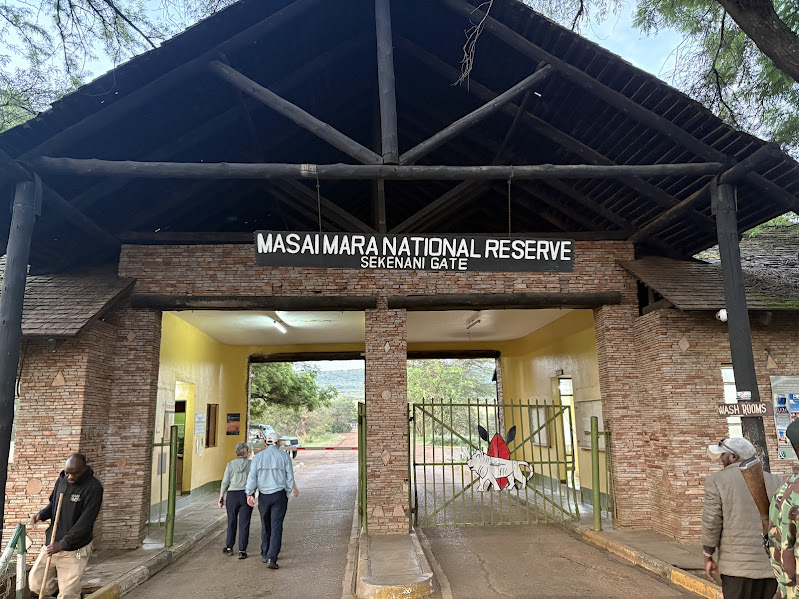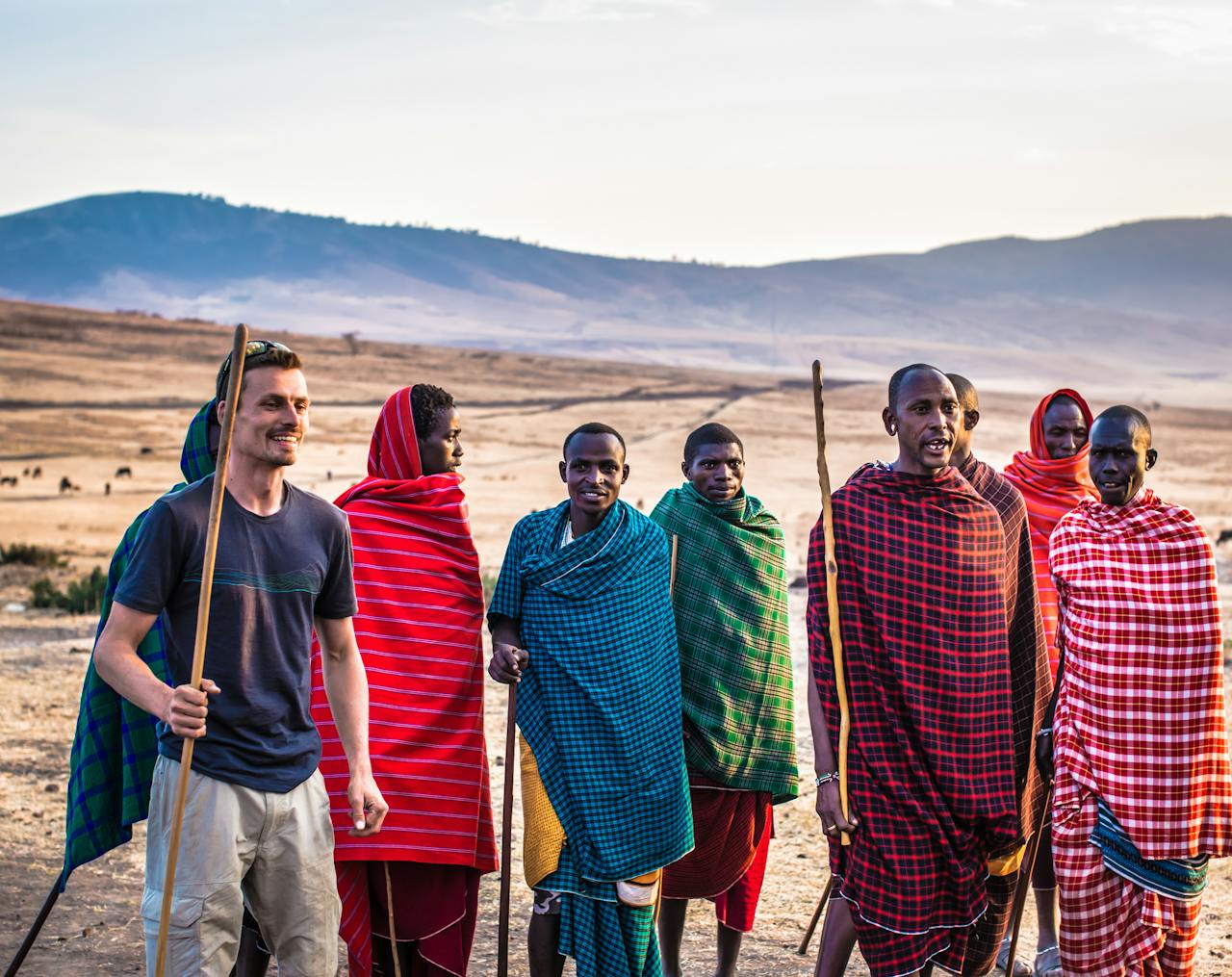Your Official Guide to Exploring Kenya’s Most Popular Reserve
Welcome to MasaiMara.ke—your trusted go-to resource for everything you need to know about the Masai Mara National Reserve. Whether it’s your first safari or your tenth, we’ll help you plan every detail: from choosing the right 4×4 to picking the perfect tent and uncovering those hidden wildlife gems.
About Masai Mara:
Located in southwest Kenya’s Narok County, the Masai Mara National Reserve is a vast savannah wilderness celebrated for its rolling grasslands, winding rivers, and abundant wildlife. Spanning 1,510 km², this iconic reserve sits at the northern edge of the Serengeti–Mara ecosystem, where the legendary Great Wildebeest Migration paints the plains with over a million hoofbeats each year—yet still feels wonderfully untouched. It lies approximately 80 km west of Narok town and 230 km from Nairobi, within Kenya’s Rift Valley region in East Africa.
Ringed by 23 Maasai-managed conservancies—such as Naboisho, Olare Motorogi, and Mara North—the Mara forms part of a 3,586 km² community-driven conservation landscape. Here, acacia-dotted horizons, dramatic escarpments, and riverine forests provide sanctuary to dense populations of lions, elephants, cheetahs, and more than 500 bird species, all while empowering local Maasai communities through eco-tourism and land stewardship.
About The Larger Masai Mara Ecosystem:
The Masai Mara–Serengeti ecosystem forms the northern reaches of the famous Great Wildebeest Migration “circuit,” often hailed as the Eighth Wonder of the World for its sweeping herds and unparalleled biodiversity. At its core sits the 1,510 km² Masai Mara National Reserve—protected savannah teeming with lions, elephants, cheetahs and the annual migration.
The Masai Mara–Serengeti ecosystem forms the northern reaches of the great Serengeti–Mara wildlife landscape, often hailed as the “Eighth Wonder of the World” for its spectacular Great Wildebeest Migration and unrivaled biodiversity.

Together, they make up the 3,585.86 km² Greater Mara Ecosystem—one of Africa’s largest community-based conservation landscapes, designed to safeguard migratory corridors, limit tourism density, and reinvest revenue into wildlife protection and local livelihoods.
The Masai Mara Wildlife Conservancies Association reports that its 23 community conservancies encompass 207,586 hectares (513,095 acres) of territory, all leased from upwards of 17,300 Maasai landowners.
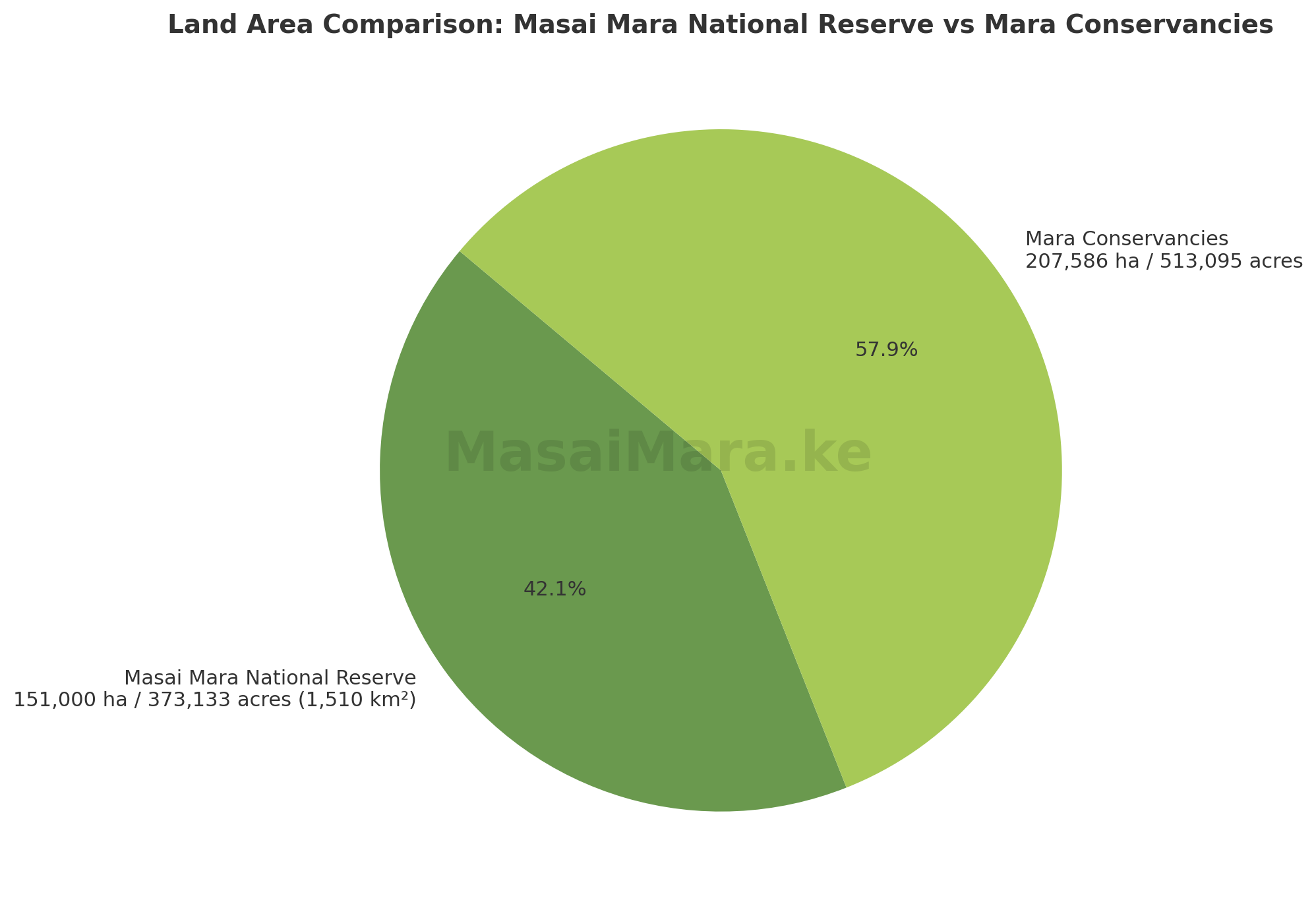
A Glimpse Into History
It’s been 77 years since Masai Mara was first gazetted in 1948 as a wildlife sanctuary—an early recognition of its critical importance for elephants, lions, and migratory herds. Expanded to a Game Reserve in 1961 and designated a National Reserve in 1974, Masai Mara set the benchmark for Kenya’s conservation vision. Its very name—“Mara,” meaning “spotted” in Maasai—evokes the dark acacia “spots” dotting the golden plains.
🌟 Why Visit?
Each year, over 300,000 visitors flock to the Mara, making it Kenya’s most visited protected area and a cornerstone of African wildlife tourism. Here’s why it reigns supreme:
- Unprecedented Migration: Witness 1.5 million+ wildebeest, zebra & gazelle negotiate crocodile-infested rivers in the planet’s largest terrestrial migration.
- Record Wildlife Density: With an average of 3,400 large mammals/km² and lion densities of 0.2–0.4 lions/km², predator and prey encounters are virtually guaranteed.
- Picture-Perfect Landscapes: From the Oloololo Escarpment’s ochre cliffs to the meandering Mara River, every sunrise and sunset is a masterclass in safari cinematography.
- Authentic Maasai Culture: Engage with Maasai communities—watch warrior dances, learn beadwork, and support community-run conservancies.
- Diverse Safari Experiences: Choose dawn game drives, sunrise balloon flights, tracked walking safaris, or exclusive night drives in low-density conservancies.
- Proven Conservation Model: Community conservancies cap visitor numbers, channel revenue into local schools and anti-poaching, and maintain critical wildlife corridors.
🚗 Getting There: How to Access Maasai Mara
🛣️ By Road
- Distance & Duration: Approximately 230 km from Nairobi (5–6 hours by 4×4 safari vehicle).
- Typical Route:
- Nairobi → Narok (tarmac, ~3 hours)
- Narok → Sekenani or Talek Gate (all-weather but rough; 2–3 hours)
- Road Conditions: Paved highway to Narok, then graded dirt roads into the reserve—4×4 recommended, especially during short rains (Nov–Dec) and long rains (Mar–May).
- Tips:
- Depart Nairobi by 7 AM to avoid city traffic and arrive before midday heat.
- Pack snacks, water, and a spare tire; cell coverage is patchy beyond Narok.
🛬 By Air
- Charter & Scheduled Flights:
- Wilson Airport (NBO): Daily light aircraft flights to Mara airstrips.
- Jomo Kenyatta Intl (NBO): Limited charters available.
- Airstrips Serving the Mara: Keekorok, Ol Kiombo, Mara Serena, Olkiombo, Siana, and a handful of private strips.
- Flight Time: ~45 minutes.
- Transfers: Most camps and lodges include airstrip pick-up; confirm your arrival time 24 hours in advance.
Key Entry Gates:
- Sekenani Gate: Main entry point, closest to many accommodations.
- Talek Gate: Convenient for lodges near the Talek River.
- Musiara Gate: Access to the central plains.
- Oloololo Gate: Entry to the Mara Triangle.
✈️ Insider Advice
- Early Arrivals: Flights depart early to catch morning game drives; plan buffer time for weather delays.
- Self-Drive vs. Guided Transfer: If you prefer flexibility, self-drive from Narok—otherwise, many operators offer private shuttle vans.
- Combine Modes: Fly in for game drives, then self-drive out to explore conservancies at your own pace.
Whether you roll in overland or soar in by air, arriving with daylight still on the plains will maximize your first glimpses of Mara wildlife. Safe travels!
- By Road: 5–6 hrs from Nairobi via Narok; 4×4 recommended for unpaved sections
- By Air: 45 min with passenger flighs from Wilson Airport to Masai Mara airstrips
- Entry Gates: Sekenani, Talek, Musiara (central), Oloololo (Triangle)
🌦️ Climate & Best Times
The Masai Mara lies at 1,500–1,800 meters elevation and enjoys a temperate savannah climate with two rainy seasons and two drier periods:
- Daytime temperatures: 20–30 °C (68–86 °F)
- Nighttime lows: 10–20 °C (50–68 °F)
- Long rains: March–May
- Short rains: November–December
- Dry seasons: January–February and June–October
During the dry months, wildlife congregates around rivers and waterholes, making game drives especially rewarding.
Each season paints the Mara in a different light—plan around rain, migration, or calving.
- Dry Season (Jun–Oct): Prime game viewing; Migration river crossings
- Short Rains (Oct–Dec): Lush scenery; fewer crowds; excellent birding
- Long Rains (Mar–May): Calving season (Jan–Feb); dramatic skies; newborn wildlife
💳 Entry Fees (2025)
Below are the current fees for non-residens, Kenyan citizens and EAC residents:
| Visitor Type | Jan–Jun | Jul–Dec | Child (9–17) |
|---|---|---|---|
| Non-Resident | USD 100/day | USD 200/day | USD 50/day |
| Kenyan Citizen | KES 1,500/day | KES 3,000/day | KES 300/500/day |
| EAC Resident | KES 2,500/day | KES 5,000/day | KES 1,000/2,000 |
| Vehicle Fees | KES 1,000–5,000/day (size-based) |
What to Expect on your safari:
- Big Five Chances: While lions, buffaloes, and elephants are frequently spotted, rhinos and leopards remain elusive—never say never, but don’t plan your entire trip around them.
- Predator Prime Time: Rise before dawn to catch lions on the prowl and early-morning bird activity; daylight drives risk missing peak predator behavior.
- Cheetah Courtesy: Always keep a respectful distance from cheetahs—too-close viewing can disrupt their hunting and breeding.
- Rest & Refuel: MMNR offers rest stops at the main entry gates and at Lookout Hill above Purungat Bridge—ideal for stretching legs, grabbing snacks, and snapping photos.
- Wildlife Conflicts: Human–wildlife tensions flare occasionally—most recently a lion was tracked and removed near Ololamuitia after livestock losses. Rangers and community outreach programs work continuously to mitigate such incidents.
- High Entry Fees: Following the 2024 increase, daily park fees can strain your budget—consider shared game drives and budget-friendly camps like Kambu Mara Camp to optimize costs.
- Shared Drives: Joining a small-group safari spreads the cost of your guide and vehicle, making it easier to absorb steep park and vehicle fees.
- Budget Stays: Camps like Kambu Mara Camp offer clean, comfortable tents and communal dining at a fraction of luxury-lodge rates—perfect for value-minded travelers.
- Vehicle Etiquette: Stay inside your 4×4, follow your guide’s lead, and never block migration paths or watering holes; respectful viewing keeps the Mara safe for wildlife and guests alike.
- Be Prepared: Pack layered clothing for cool mornings and warm afternoons, plus binoculars, plenty of water, and snacks for full-day safaris—you’ll cover dozens of kilometers off-road in search of unforgettable encounters.
🏨 Accommodation
From budget tents to luxe lodges, the Mara delivers comfort at every level.
- Budget Camps (USD 110–210): Shared tents, basic amenities (e.g., Kambu Mara Camp)
- Mid-Range Lodges (USD 200–400): Private safari tents, en-suite bathrooms
- Luxury Lodges (USD 400–1,000+): Plunge pools, spa facilities, gourmet dining
- Mobile Camps: Seasonal pop-ups near Migration hotspots for ultimate immersion
🐾 Safari Activities
Tailor your Mara adventure—game drives, balloon flights, walks, cultural tours, and more.
- Game Drives: Morning, afternoon, or full-day in pop-roof Land Cruisers
- Hot-Air Balloon: 1-hr sunrise flight + champagne breakfast
- Walking Safaris: Private conservancies only, for close-up natural history
- Cultural Visits: Maasai manyatta tours, traditional dances, craft demonstrations
- Night Drives: Exclusive in conservancies to spot nocturnal predators
🚙 Safari Vehicles
Choosing the right wheels ensures comfort and safety across Mara terrain.
- 4×4 Land Cruiser: Ultimate off-road reliability, pop-roof viewing
- Safari Van: Budget-friendly with pop-roof; best in dry conditions
- Private Transfers: Toyota Probox/Noah for camp ↔ airstrip and local transfers
🌿 Conservation & Community
The Greater Mara’s community-based model safeguards wildlife corridors and empowers Maasai landowners.
- 3,586 km² Greater Mara: One of Africa’s largest community-conservation landscapes
- Revenue Sharing: Conservancy fees fund schools, healthcare, anti-poaching patrols
- Sustainable Tourism: Low visitor density, no large infrastructure, ecosystem integrity
🧭 Plan Your Visit
Early planning and the right expert partners unlock a seamless, unforgettable safari.
- Book Early: Secure lodging, vehicles, and balloon slots well in advance
- Travel Insurance: Protect against delays, cancellations, or medical emergencies
- Local Guides: Hire experienced Maasai guides for insider knowledge and safety
- Packing List: Neutral layers, sturdy boots, binoculars, camera, sunscreen, reusable bottle
Planning your Visit to Masai Mara
Why Visit the Masai Mara?
The Masai Mara National Reserve is one of Africa’s premier wildlife destinations and is Kenya’s most popular tourist destination. Below are the key reasons this Reserve is worth visiting;
- Established Heritage: Founded in 1961, the Maasai Mara is one of Africa’s oldest protected reserves and a testament to conservation history. Despite facing challenges like poaching and habitat loss, it has evolved into a global model for sustainable wildlife management.
- Great Migration Spectacle: Hosts the Great Migration, a world-renowned natural wonder featuring over 1.5 million wildebeest, zebras, and gazelles navigating predator-rich landscapes and the Mara River.
- Wildlife Diversity: Renowned for the Big Five and rich predator populations, including lions, leopards, and cheetahs, alongside over 500 bird species and countless herbivores.
- Stunning Landscapes: Golden savannahs, the Oloololo Escarpment, and winding rivers create iconic African scenery, especially magical at sunrise and sunset.
- Cultural Richness: Named after the Maasai people, the reserve offers authentic experiences, including village visits, warrior dances, and insights into Maasai traditions.
- World-Class Safaris: Offers thrilling game drives, hot air balloon safaris, and walking safaris for up-close wildlife encounters and unique adventures.
- Conservation Success: Private conservancies like Olare Motorogi and Naboisho exemplify sustainable tourism by balancing wildlife protection, local livelihoods, and eco-tourism.
- Accommodation for All: Features luxury lodges, mid-range camps, and budget options, providing a range of stays that blend comfort with wildlife proximity.
- Accessibility: Easily reachable by air or road, making it a key destination for global travelers and safari-goers.
- Global Conservation Model: Overcoming historical challenges, the Maasai Mara exemplifies modern conservation by integrating local communities, tourism, and wildlife management for long-term sustainability.
2. When to Visit – Here are the Best Times to Visit Masai Mara
The Masai Mara is a year-round destination, but certain times offer unique experiences:
| Season | What to Expect |
|---|---|
| Dry Season (June – October) | Ideal for game viewing and the Great Migration. Grassy plains are short, and animals gather around water sources. |
| Wet Season (November – May) | Lush landscapes, fewer tourists, and birding season (November to April). January-February is calving season, attracting predators. |
3. But How do you Get to the Masai Mara?
From Nairobi
- By Road: A 5-6 hour drive from Nairobi. Ideal for scenic views and cost savings. A 4WD safari vehicle is highly recommended due to rough roads near the Mara.
- By Air: Flights from Wilson Airport (Nairobi) to airstrips like Keekorok or Mara Serena take 45 minutes. Great for saving time. See all Masai Mara Airstrips here.
Key Entry Gates:
- Sekenani Gate: Main entry point, closest to many accommodations.
- Talek Gate: Convenient for lodges near the Talek River.
- Musiara Gate: Access to the central plains.
- Oloololo Gate: Entry to the Mara Triangle.
4. You’ll Need a Place to Stay – Choosing Your Accommodation
The Masai Mara offers a range of options to suit every budget:
| Type | Features | Examples |
|---|---|---|
| Budget Camps | Affordable tents or basic accommodations with shared amenities. | Kambu Mara Camp, Miti Mingi Eco-Camp. |
| Mid-Range Lodges | Comfortable rooms or safari tents with better amenities and private bathrooms. | Mara Simba Lodge, Fig Tree Camp. |
| Luxury Lodges | High-end facilities, private plunge pools, gourmet dining, and premium locations. | Angama Mara, Mahali Mzuri. |
| Mobile Tented Camps | Temporary camps set up during the Great Migration, offering a close-to-nature experience. | Alex Walker’s Serian. |

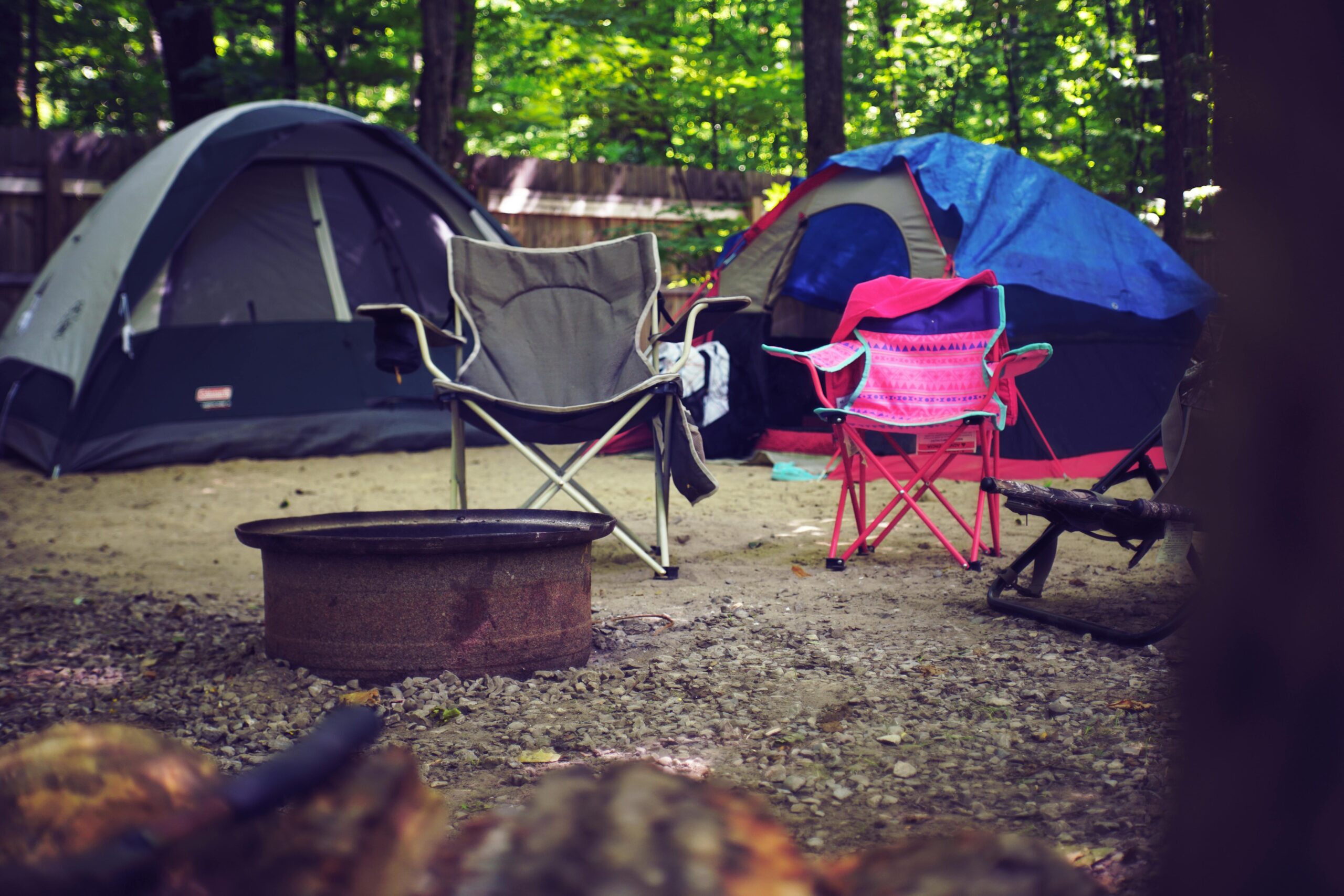
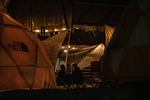
5. Masai Mara Safaris
Masai Mara safaris are categorized into Road Safaris, Air Safaris, and Budget-Based Safaris, offering flexibility in duration, budget, and activities.
- Road Safaris: These scenic drives from Nairobi are perfect for travelers seeking cost-effective options or immersive experiences. Budget packages offer basic camping and short game drives (2 Days: $200–$300). Mid-range options include comfortable lodges and cultural visits (3 Days: $500–$800), while luxury packages offer premium lodges, hot air balloon safaris, and extended exploration (4 Days: $1,500–$2,000).
- Air Safaris: Designed for efficiency and exclusivity, these safaris include flights to the Mara, saving travel time. Budget options focus on affordable lodges (2 Days: $700–$900), mid-range safaris provide enhanced amenities (3 Days: $1,400–$1,800), and luxury packages offer premium lodges and private game drives (4 Days: $3,000–$4,000).
- Price-Based Safaris: Tailored to financial preferences, these packages range from basic camping to luxury accommodations. Budget options emphasize affordability (3 Days: $300–$450), mid-range safaris balance cost and comfort (4 Days: $800–$1,200), and luxury safaris deliver unparalleled experiences with exclusive lodges and premium activities (4 Days: $2,500–$4,000).
Planning Your Safari Activities
The Masai Mara offers a variety of activities for every type of traveler:
Game Drives
- Morning, afternoon, or full-day drives to explore the savannah.
- Best way to see Big Cats, elephants, and other wildlife.
Hot Air Balloon Safaris
- Drift over the plains at sunrise and enjoy a champagne breakfast. Book in advance as slots fill up quickly.
Walking Safaris
- Available in private conservancies. Great for learning about flora, tracks, and smaller wildlife.
Cultural Visits
- Visit a Maasai village to learn about their culture, dances, and beadwork.
Night Safaris
- Only allowed in conservancies, offering a chance to see nocturnal animals like leopards and bush babies.
Choosing the Right Safari Vehicle
Vehicle Options
- 4WD Safari Land Cruiser:
- High ground clearance and reliability on rough terrain.
- Features include pop-up roofs for unobstructed viewing and charging ports.
- Ideal for all seasons, particularly during the rainy months.
- Safari Minivan:
- Budget-friendly with pop-up roofs for game viewing.
- Suitable for dry seasons and shorter trips but less robust in muddy conditions.
- Private Vehicles:
- Recommended for exclusive safaris with tailored itineraries.
- Luxury options include Land Cruisers with enhanced suspension and comfortable seating.
Tips for Renting Safari Vehicles
- Book through reputable companies like Kambu Campers or MasaiMara.ke, known for reliable 4WD rentals.
- Confirm the vehicle is equipped with essentials like first-aid kits, GPS, and UHF radios.
- Discuss the rental terms, including mileage limits and insurance coverage.
Masai Mara Conservancies vs. Reserve Safaris
Consider exploring the private conservancies around the reserve for a more exclusive experience:
| Reserve | Conservancies |
|---|---|
| Larger area; higher visitor numbers. | Limited vehicles, ensuring a more private experience. |
| No night drives or walking safaris. | Activities like night drives, bush walks, and off-road driving allowed. |
| Focuses on mass tourism. | Focuses on low-impact, sustainable tourism. |
Notable conservancies: Naboisho, Olare Motorogi, Mara North.
9. What to Pack
- Neutral-colored clothing (light layers for day/night temperature variations).
- Comfortable walking shoes and a wide-brimmed hat.
- Binoculars and a camera with a zoom lens.
- Sunscreen, insect repellent, and a reusable water bottle.
10. Masai Mara Park Fees and Costs
- Entry Fees:
- Non-residents: $200 per adult for 12 hours (National Reserve).
- Conservancies: Fees vary by conservancy, typically $100-$120 per adult per day.
- Additional Costs:
- Accommodation rates.
- Vehicle rental or guided tour costs.
- Optional activities (balloon safaris, cultural visits).
11. Masai Mara Conservation and Responsible Tourism
Visiting the Masai Mara is not just about enjoying its beauty but also contributing to its conservation:
- Choose eco-friendly lodges and camps.
- Respect wildlife by maintaining safe distances and minimizing noise.
- Support local communities by purchasing Maasai crafts or booking cultural experiences.
12. Tips for a Seamless Masai Mara Safari
- Book Early: Secure accommodations, vehicle rentals, and balloon safaris in advance.
- Travel Insurance: Covers unexpected delays, cancellations, or emergencies.
- Guides Matter: Experienced guides enhance your safari with knowledge and insights.
- Stay Flexible: Weather and animal behavior can be unpredictable.
13. MMNR FAQs
- How long should I stay?: A minimum of 3 days is recommended to explore the reserve and surrounding conservancies.
- Is the Masai Mara safe?: Yes, it’s safe for visitors. Guides and camps prioritize your safety.
- Can I self-drive?: Yes, but hiring a guide is highly recommended for spotting wildlife and navigating the terrain.
Masai Mara Reserve in the News:
- Higher Masai Mara game park fees send tourists to Serengeti as season starts, Business Daily, July 2024
- Kenya to close all airstrips in Maasai Mara Game Reserve
- Ruto Orders Construction of New International Airport by March 2026
- Fire Breaks Out at Maasai Mara National Reserve
- Africa’s famous Serengeti and Maasai Mara are being hit by climate change – a major threat to wildlife and tourism
- The Ritz-Carlton, Masai Mara Safari Camp Set to Offer Elevated Luxury in the Wild
- Tourists and staff evacuated from Kenya’s flood Maasai Mara national reserve
- Hoteliers pick up the pieces after Maasai Mara flooding
14. Why Choose MasaiMara.ke?
At MasaiMara.ke, we’re dedicated to making your Masai Mara adventure unforgettable:
- Expert advice on planning and customizing your safari.
- Reliable 4WD vehicle rentals tailored for safari needs.
- Insider tips and local knowledge to maximize your experience.
Plan Your Epic Safari Today!
With its unmatched wildlife, breathtaking landscapes, and vibrant culture, the Masai Mara promises a safari like no other. Let MasaiMara.ke be your guide to planning the ultimate adventure. Contact us to start your journey!
Masai-British 1904 and 1911 Agreements
Background The Maasai, a pastoralist community in present-day Kenya, were historically dominant across large parts…
Fly ALS Flights: Wilson (Nairobi) to Maasai Mara & Back
1. Flight Schedule Fly ALS operates two scheduled daily flights between Wilson and the Maasai…
Safarilink Flights
1. Flight Schedule Safarilink offers multiple daily flights from Wilson Airport to all main Maasai…
AirKenya Flights to Maasai Mara
1. Flight Schedule (Wilson ↔ Maasai Mara) AirKenya offers multiple daily flights, serving all major…
Ultimate Guide to Nairobi National Park
The World’s Only Urban Safari Experience Introduction Nairobi National Park is a one-of-a-kind destination: Africa’s…
FAQs
1. What is the Masai Mara National Reserve? The Masai Mara National Reserve (MMNR) is…
Car Rental in Talek Town
Introduction Talek Town, located near Talek Gate, is one of the key entry points to…
Commercialization of Masai Village Visit and How to Have Responsible Ethical Visit
Visiting a Maasai village is often marketed as an authentic cultural experience, offering travelers the…
Mara Plains Camp– Ultimate Luxury in the Heart of the Masai Mara
🏞️ Overview Mara Plains Camp is one of the most exclusive safari lodges in Kenya,…
Porini Cheetah Camp– An Authentic Safari Haven in Ol Kinyei Conservancy
🌍 Overview Tucked into the heart of Ol Kinyei Conservancy, Porini Cheetah Camp is one…
Offbeat Mara Camp
🌍 Overview Offbeat Mara Camp is a true gem for safari purists seeking an authentic,…
Saruni Mara
🌍 Overview Saruni Mara is an intimate and exclusive safari lodge tucked away in the…
Richard’s River Camp
🌍 Overview Richard’s River Camp is a small, exclusive luxury safari camp set in the…
Cottar’s 1920s Safari Camp – Classic Elegance on the Edge of the Wild
🦓 Overview Cottar’s 1920s Safari Camp is not just a lodge—it’s a time machine that…
Kicheche Mara Camp
🌍 Overview Kicheche Mara Camp is a timeless, boutique-style safari camp located deep within the…
Rekero Camp
🌍 Overview Rekero Camp is a classic tented safari camp set on the banks of…
Mara Kempinski
Olare Mara Kempinski is a luxurious safari camp nestled within the exclusive Olare Motorogi Conservancy,…
Governors’ II Moran Camp
🌍 Overview Governors’ Il Moran Camp is the most luxurious and intimate of the renowned…
Mara Expedition Camp
🌍 Overview Mara Expedition Camp is a small, exclusive, and elegantly rustic safari camp that…
Ol Seki Hemingways Mara Camp
Naboisho 🌍 Introduction Tucked away in the heart of the Mara Naboisho Conservancy, Ol Seki…

